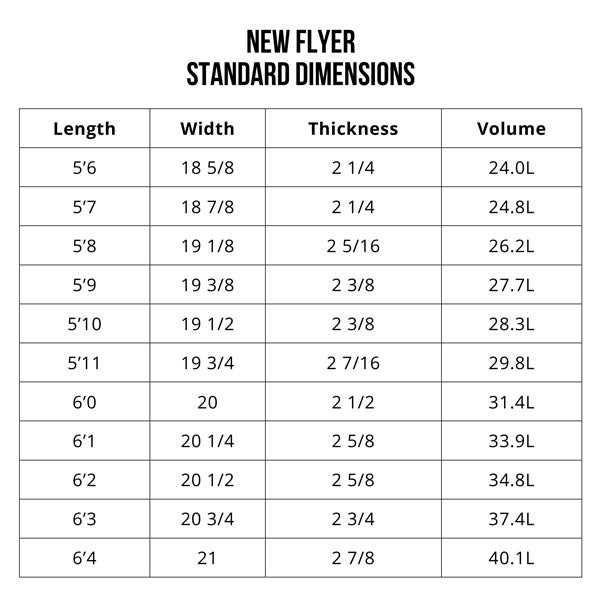OG Flyer Vs New Flyer: How To Choose
THE BOTTOM LINE
Compared directly to the New Flyer, the OG Flyer has a straighter outline and is ridden longer in length to give the board more drive and down the line speed and uses that drive and mellow rocker to glide over sections as well as handle larger surf. Whereas, the increased curves of the New Flyer make it a favorite of surfers in tighter more pockety waves where more vertical surfing is necessary.

A BRIEF HISTORY
Introduced in 1999, the Flyer rapidly became one of Al’s most sought after designs for small to medium-sized waves. Since then, the board has gone through numerous iterations to accommodate the needs of our team and customers alike. Due to popular demand, some of the most common requests culminated in the release of the New Flyer in 2013 and OG Flyer in 2017. Yes, you read that correctly, the New Flyer came before the OG Flyer; both are variations of the first version released in ’99. Each model offers considerable get-up and go, but which one is right for you?
EXPLANATION
When you have two amazing boards that come from the same DNA, deciding between them can be a difficult decision. Knowing this, we laid out a side by side comparision to help clear up any confusion about these iconic grovelers.
OG FLYER
CI’s head shaper Britt Merrick claims that of all the Flyer variations, the OG Flyer “is as close as we can get to the original intent of what my dad was doing with those top surfers in the late 90’s.”

Best as an everyday board in everyday conditions, the OG Flyer has a single concave entry to double through the middle and a vee exit, Al’s signature bump squash, slight down rail, and a subtle nose beak.

As a daily driver, often called a California Shortboard, the OG Flyer cannot be beat for its all-around versatility. It is designed to be ridden approximately the same length as you are tall. Conner is 5’8, 167lbs and rides a 5’9″ x 18 5/8″ x 2 5/16″.

Following the board’s release, Noel Salas gave it his stamp of approval by naming it a favorite among the models he reviewed in 2017. At 5’9, 170lbs, Noel considers his stock 5’8 x 18 3/4″ x 2 5/16″ to be a daily driver that’s versatile in 2-6ft surf. According to Salas, 5’8 falls between his normal groveler and shortboard lengths, and he was impressed by the board’s ability to perform in a range of waves that he usually relies on two boards to cover.
NEW FLYER
According to Britt, “Bobby Martinez has been instrumental in the development of this board. If you watch Bobby surf, he’s incredible. He’s so fast. He’s so quick and yet he’s so powerful and agile, and generates speed in all sorts of places. That’s how this board surfs, like Bobby. When you get this board you’ll surf just like Bobby—probably not, but there’s a chance.”

Redistributing the foam found in the beak nose of the Flyer and OG Flyer allows this plan-shape to maintain the same volume in a shorter and curvier rail line. We kept the forgiving 2-stage rocker and added spiral vee starting in front of the fins to allow for rail-to-rail quickness. Furthermore, the signature Merrick hip provides a pivot point for tight arcs in the pocket.

Bobby is 5’7, 165lbs and rides a 5’6 x 19″ x 2 5/16″ New Flyer with a quad fin set up.

The New Flyer’s dimensions are modernized into a shorter and wider package. It is available in standard and groveler dimensions, which provides a lot of options when grabbing a stock board off the rack.

When Bobby stepped away from the contest scene several years ago, he began trying dimensions that were completely different than the boards he rode on tour. Back then a go-to board would be 6’0 x 18 3/8″ x 2 5/16″, but now he’s on a 5’6 x 19″ x 2 5/16″.
STILL UNSURE?

If you’re still unsure which one is right for you, check out the reviews of the OG Flyer and New Flyer for more insight. You can also use the compare tool for a side by side look of their dimensions, features, and conditions they were designed for.

